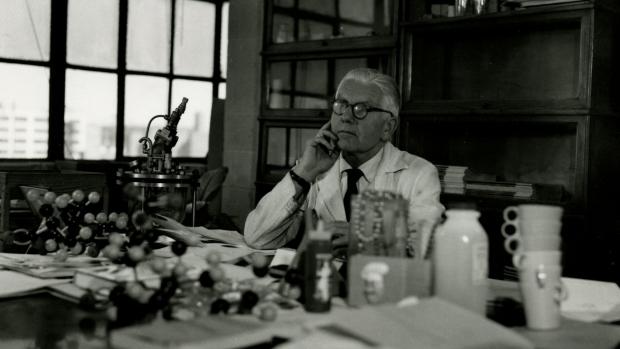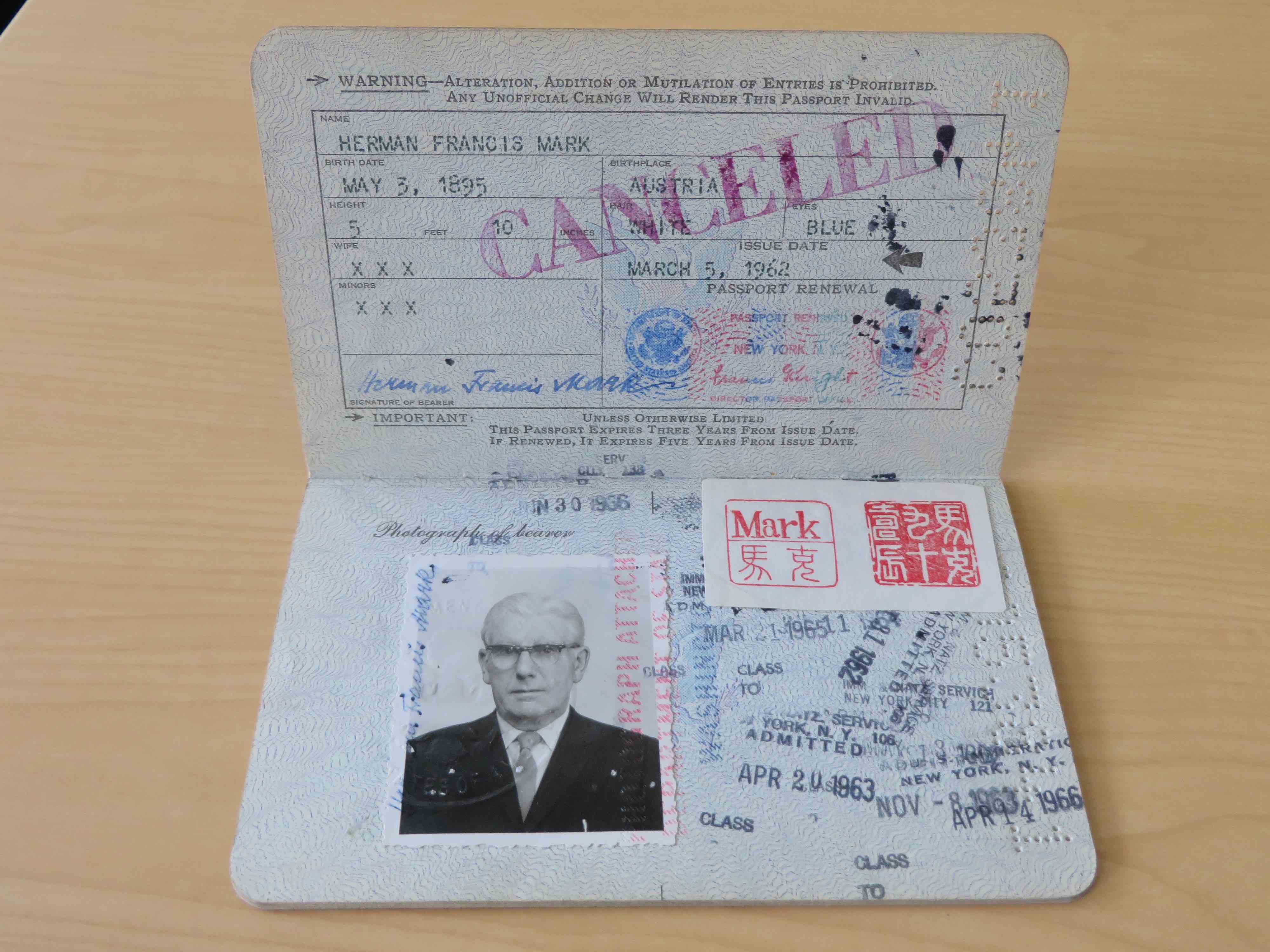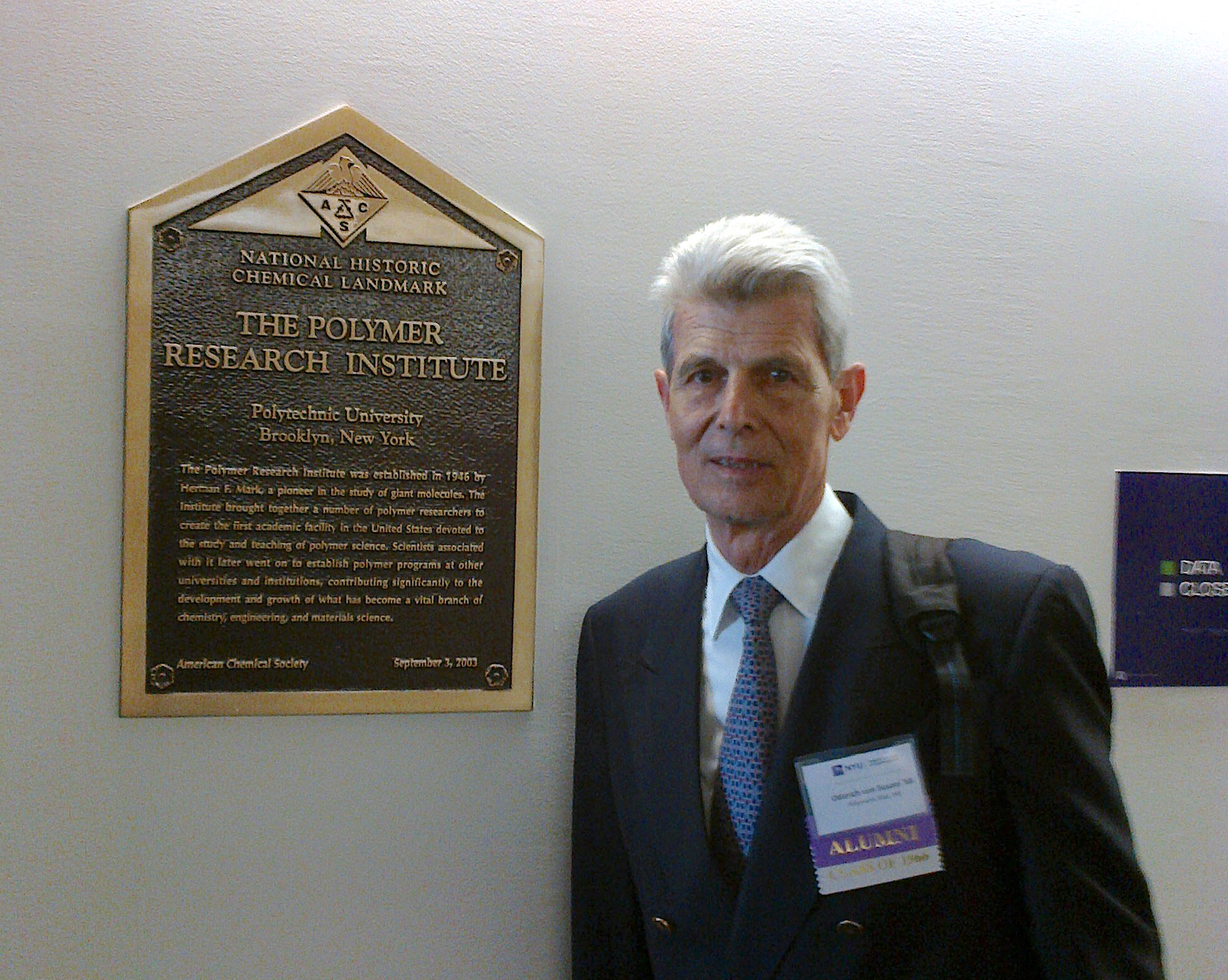Herman Mark: A milestone birthday for a scientist of milestone accomplishments

Herman Mark (Photo from the Poly Archives)
It would be difficult to overstate the importance of Herman Mark to both science and the NYU Tandon School of Engineering, which during his tenure was known affectionately as Poly. Called the “Father of Polymer Science,” Mark made the school an epicenter of the field, and students flocked from all over the world to study with him.
Reminiscing in advance of Mark’s birthday (May 3), Lindsay Anderberg, our school’s archivist, describes her discovery of his work:
"In 2012, I met the late Professor Eli Pearce, one of Herman Mark’s former students. My conversations with Eli, a beloved faculty member here for decades, gave me the context to understand Herman Mark not only as the Father of Polymer Science, but also as a gifted teacher and well-loved mentor. Eli connected me to other living students of Mark’s, identified people in unlabeled photographs, and led me to many boxes of Mark’s archives that had been stored in an old lab closet in Rogers Hall. After connecting with Herman Mark’s son, Hans Mark, I secured a donor agreement to the 60-linear-foot Herman F. Mark Collection, which not only documents Mark’s professional contributions to the field, but also includes personal writings, correspondence, photographs, artwork, and ephemera (such as the passport shown below). 
In the six years since that donor agreement was signed, items from the Herman Mark Collection have been used in an average of 10 undergraduate classes per year. By my rough estimate, this means approximately 900 Tandon students have learned about their connection to the Father of Polymer Science! As the Poly Archivist, it’s very rewarding to keep this important piece of our history alive with new generations of engineers. Happy 125th birthday, Herman Mark!"
While much biographical information has been published, writing from his home in Geneva, Switzerland, Odorich “Rick” von Susani, an alum and former student of Mark, who was born in 1895, offered this rare and personal remembrance in honor of the milestone 125th birthday.
Alum “Rick” von Susani Remembers Herman Mark
How I became aware of Herman Mark
"When I was finishing my Diplom Ingenieur (the equivalent of a master’s) degree in Technical Chemistry in 1964 at the Graz University of Technology in Austria, I wanted to specialize in a field that was close to practical daily life. I chose polymers and plastics and began to research where this would be possible. Soon I found out that the Polytechnic Institute of Brooklyn, in New York, was offering a new degree: 'Master of Science in Polymeric Materials.' I became very interested. In discussions in the family about my project it turned out that an uncle of my mother, who had been a professor of physics at the University of Vienna before WW II, knew Herman Mark as a colleague. When he informed me, 'He is an excellent scientist and teaches now at the Polytechnic Institute of Brooklyn,' that was decisive for me. I applied for and was granted a Fulbright Scholarship, which covered tuition and travel to and from the USA, and I was accepted into the master’s program in Polymeric Materials."
Herman Mark as a teacher
"In the Polymeric Materials program, Professor Mark’s lecture was entitled 'Introduction to Macromolecular Chemistry.' It was a key part of the program and a masterpiece of didactic art, both entertaining and instructive. We, the students, were hanging with our eyes on him. His lectures were interesting, understandable and, what was so remarkable, one could retain practically 100 percent of their content. There were many other excellent professors in the polymer field like Overberger, Morawetz, and Bruins, but Mark definitely stood apart. He conveyed to me a basic understanding of polymer science that helped me later throughout my professional career. What I did not realize at the time was that 1964-65 was the last year Professor Mark was teaching, since he turned 70 years old in 1965. Without knowing it, I was lucky to have benefitted from a lifetime of teaching experience, and I am very thankful for that.
Retaining the lectures well also meant getting good grades in the exams that we had almost weekly and that was new to me. This was also very important for me. In the mid-1930s my father, a professor of surgery, had been a visiting professor at the Mayo Clinic in Rochester, Minnesota. On his way back to Austria he set up an educational trust for his children with the Scarsdale National Bank and Trust Company, just north of New York City, to provide for the 'education of his children in the United States at university level.' Since my Fulbright Scholarship did not cover living expenses, I needed to present myself in person several times at the Bank with my grades from Polytechnic to obtain the funds needed to live in Brooklyn.
In mid-August 1965 I finished my master’s thesis under the direction of Professor Bruins on 'Ion exchange membranes for sea water desalination by reverse osmosis.' A week later I married Christa, my fiancée from Graz, who had joined me in Brooklyn. After the wedding ceremony at City Hall in Manhattan, we walked back over the Brooklyn Bridge to Brooklyn Heights, where we rented an apartment in a historic brownstone house at 19 Cranberry street. That house, incidentally, later became famous for its role in the movie Moonstruck.
Shortly after our return from the wedding ceremony, I received a phone call from a Human Relations Manager at DuPont in Wilmington, Delaware, that was decisive for my professional career and my continued relationship with Herman Mark. He invited me for a job interview, and I subsequently received an open offer to work for DuPont. I first returned to Austria, however, to study for a Doctorate in Technical Sciences at the Graz University of Technology, which I obtained in 1967."
Herman Mark as a consultant
"In 1968 I joined DuPont and started to work in the Carothers Research Laboratory, the birthplace of nylon, at the Experimental Station in Wilmington. To my surprise, there I met Herman Mark, who visited several times per year for consultation on ongoing research projects. His arrival was always a big event. It forced us, the young research chemists, to put our high-flying ideas in good order, because time with him was very precious. I called this process, in itself already a very valuable thing, the 'Herman Mark effect.' He did not talk a lot, but when he said: 'This is interesting, carry on,' you knew that you were on the right track. But when he said: 'If I were you, I would rethink my approach,' you knew that you had to change your project.
I was working at the time on acid dyeable Dacron® polyester fibers. To dye Dacron® with wool or nylon dyes had long been a dream for the textile industry. A fellow research chemist had identified a substituted piperidine as a candidate to allow the docking on of an acid dye molecule. But the dyeing process turned out to be impractical, and I was asked to change it. I had the idea to polymerize ethylene oxide onto the piperidine to make the vicinity of the dye site more hydrophilic. When I explained this idea to Mark he said: 'Carry on.' We continued to discuss ways to limit the chain length of the polyethylene oxide to ensure not changing the basic properties of the Dacron® fiber. The project worked, and I obtained 3 U.S. patents on this together with my co-inventor.
In 1974 I was transferred by DuPont to Geneva, Switzerland. At my farewell party my colleagues presented me with a pair of trousers made in part with acid dyeable Dacron®. The red fibers of the trousers are acid dyeable, the blue fibers are cationic dyeable (not my invention), and the white fibers are regular, unmodified polyester fibers that remain undyed. The dyeing was performed all together in the same dye bath."
Herman Mark today
"In 2016 I returned to the Polytechnic Institute for the first time in 50 years for the Golden Jubilee celebration of my master’s degree. A lot of things had changed, including the name: the Polytechnic Institute had become the NYU Tandon School of Engineering. The Director of Alumni Relations, Valerie Cabral, had the excellent idea of showing me the bronze plaque in Rogers Hall that had been donated by the ACS in 2003 in honor of Mark and the Polymer Research Institute. This was indeed a very memorable moment.

Alum von Susani next to the bronze plaque commemorating Herman Mark and the Polymer Research Institute
In Vienna, Herman Mark’s birthplace, the Austrian Research Institute for Chemistry and Technology (OFI) has since 1975, the year of his 80th birthday, awarded the annual Herman Mark Medal to researchers and personalities in polymer science and the polymer industry. In 2006 the late Polytechnic Professor Eli Pearce, who had also been a student of Mark, was awarded the Medal. For the planned award ceremony in October 2020, I have been invited as a special guest, because the OFI wants to have an actual former student of Mark in honor of his 125th birthday.
As far as the trousers made with acid dyeable Dacron® are concerned, I have kept them in Geneva for all these years. The spirit of Herman Mark stays on with me forever."




